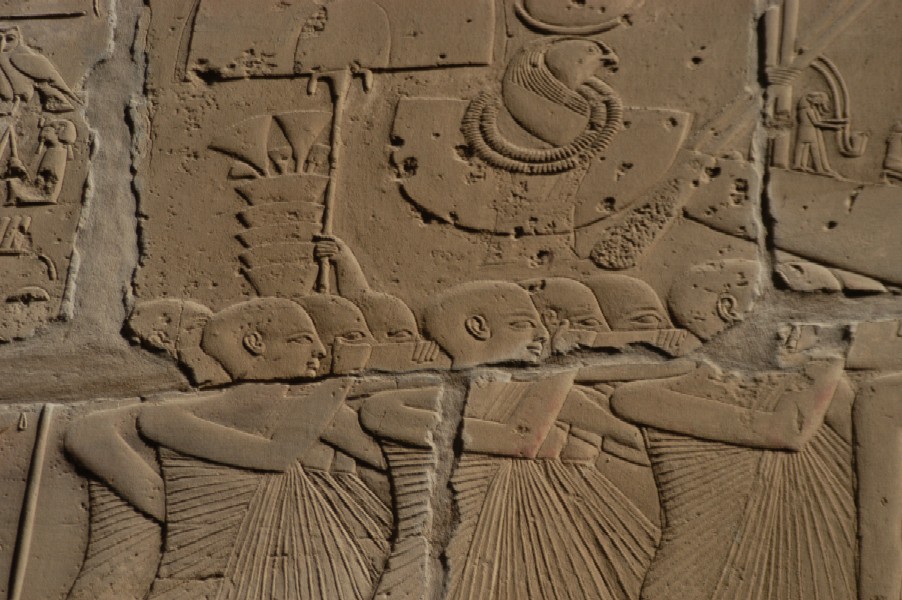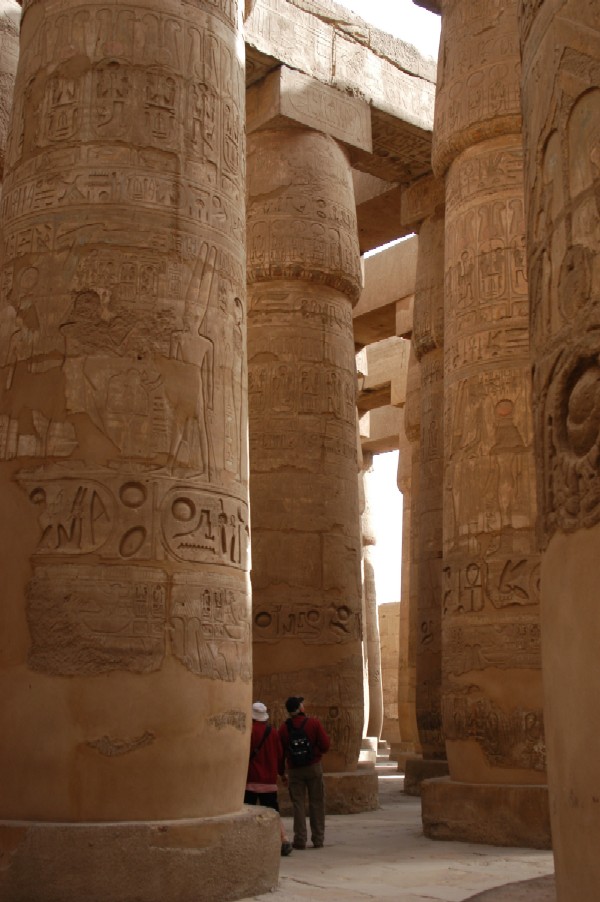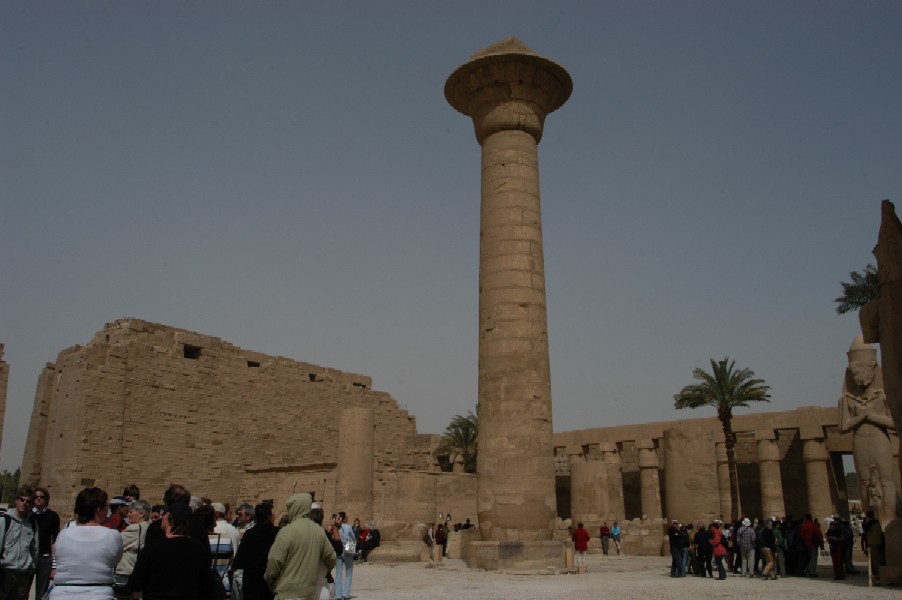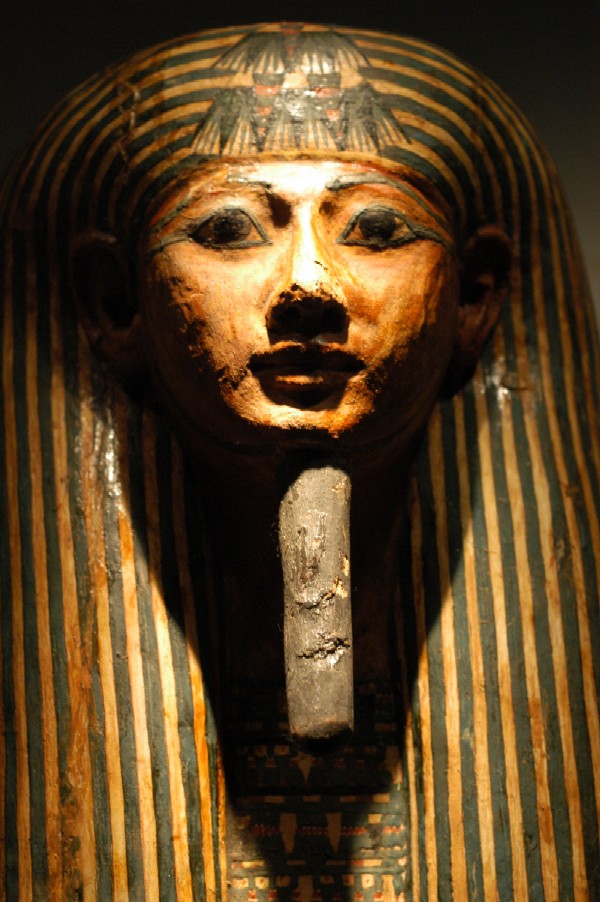February 14. LUXOR Getting to Karnak early had been the plan when we went to bed but somehow we couldn't manage it. We were tired and skeptical. The guidebook said the early morning was a good time to go to avoid the crowds but since when had they been right. We danced our way across town in a bouncy service taxi, the driver with his head wrapped in a white cloth that blew with the wind, to arrive at Karnak at 8:15. The tourist deluge had already begun. But, the gargantuan scale of the temple complex absorbed them with little bottlenecking . .
The day started out with a promise of good weather but deteriorated into cold, wind, and dust. In nearly three hours se just explored the main temple on the 100 acre site. From the front the temple looked like it went on forever with a set of massive pylons at the entrance followed by a massive courtyard, the largest we'd seen, which led to another set of massive pylons and into the undisputed highlight of Karnak, the Great Hypostyle Hall. Standing in this veritable forest of columns was an awesome experience, diminished ever so slightly by the competing voices of the endless tour group leaders. The hall covered 6000 square meters, enough space to fit BOTH London's St. Paul's Cathedral and Rome's St. Peter's Cathedral. And, the diameter of the columns rivaled a California redwood tree, reaching 15 meters, big enough for six people with outstretched arms to wrap around! The central procession was flanked by the twelve originally built columns that stood 23m high, to which 122 slightly shorter columns were later added. All of the columns and surrounding walls were covered in carvings but the styles were different. On one side they images were carved in bas-relief, a more labor intensive and delicate style that suffered more from weathering but was more impressive. The other half, finished later and with more haste, was in the sunk-in relief style of carving where the images were set into the rock, giving them a more rigid. The imagines on the inner walls were of offerings to deities, most often Amun, whose cult temple at Karnak was the largest, being the supreme god of the New Kingdom  (1567 - 1085 BC). He became so important that he was often coupled with other gods to emphasize their importance or strength, like Amun-Re when coupled with the sun god Re. (1567 - 1085 BC). He became so important that he was often coupled with other gods to emphasize their importance or strength, like Amun-Re when coupled with the sun god Re.
On the outer walls there were various battle scenes, the most interesting of which was the Ashkelon wall where one battle scene may show a fight with the Israelites since the chariots shown are of their style. Theories on who was in power at the time of Moses are varied but one suggests that it was Ramses II which contradicts the timeline popularly given to Egypt's Third Intermediate Period.
We wandered the various corners of the massive Karnak complex, a varied assortment of structures pieced together by different pharaohs, often after tearing down previous bits first. The oldest remaining part of Karnak, still visible, is the large sacred lake from the Middle Period (2056 - 1650 BC) with the latest structure, the bark shrine of Phillip Arrihdaeus, built in Greco-Roman times (332 BC - 395 AD). The court complex beyond the Hypostyle Hall is layer after layer of different pharaoh's influences, each building something smaller around the inside of the established court and ending in the small marble bark shrine.  The Hypostyle Hall, however, was built under the reigns of Ramses II, Seti I, Ramses III-XI (1186 - 1076 BC). The Hypostyle Hall, however, was built under the reigns of Ramses II, Seti I, Ramses III-XI (1186 - 1076 BC).
At the end of our tour we came upon a massive statue of a scarab beetle or dung beetle, one of ancient Egypt's mostly widely recognized symbol. The little creature had significance in several ways with the most well known one being as a protector, which is why they were commonly found on mummies. But, their role in Egyptian mythology was much more complex than that. The Egyptian's believed the sun god Re, or Atum-Re in couple with their most important of gods, rolled the sun across the sky every day in a never ending cycle. In a metaphorical way the dung beetle emerged from its hole everyday to role dung balls across the ground and into a hole for food. So, the Egyptian's related the beetle to the sun god. In addition, the beetle could be the object against which a person's heart was weighed in final judgment after death.
Feeling fully templed out, and nearly freezing, we finally left Karnak and headed back into Luxor for lunch at Amoun. From there we headed to our oasis cafe on the waterfront in the untouchable zone for touts. We spent the greater part of the afternoon there sipping tea and reading, thoroughly enjoying the hassle-free atmosphere. It wasn't until late afternoon that we finally mustered up some  energy to go see the Mummification Museum. It was a small but very well laid out one room museum along the waterfront. It only took us about 30 minutes to make a tour. The Scottish fellow we'd met on the ferry told us of a free lecture that night at the museum but as it was Valentine's Day we opted for a nice dinner out. We walked all of the way to the south end of town, near the big hotels to eat a Jem's Restaurant. When Rob told the waiters that my name was Jem that had good fun repeating my name every time they served us. My drink was Jem's drink and my dinner was Jem's chicken, well that was the name on the menu as well in that case. But we had a thoroughly lovely dinner. The food was very good and a nice departure from our repeated falafel and kebab meals at Amoun. energy to go see the Mummification Museum. It was a small but very well laid out one room museum along the waterfront. It only took us about 30 minutes to make a tour. The Scottish fellow we'd met on the ferry told us of a free lecture that night at the museum but as it was Valentine's Day we opted for a nice dinner out. We walked all of the way to the south end of town, near the big hotels to eat a Jem's Restaurant. When Rob told the waiters that my name was Jem that had good fun repeating my name every time they served us. My drink was Jem's drink and my dinner was Jem's chicken, well that was the name on the menu as well in that case. But we had a thoroughly lovely dinner. The food was very good and a nice departure from our repeated falafel and kebab meals at Amoun.
Walking back Rob was entertaining himself by teasing the touts. When they offered a taxi he offered a felucca. They found it funny and most seemed to get the point he was making. But, one caleche driver was beyond tenacious. Rob started to rib him about taking a felucca ride but he was so focused on trying to get us in his caleche that he didn't understand. He kept asking Egypt's most popular question, "Where you from?" He followed us for a couple of blocks and just wouldn't buzz off. We stopped and hid behind a telephone booth. It was just a phone on a post so he could see our legs and we heard him stop. From our position we could see a guard in front of the next building. He was eyeing the situation with amusement and we gestured to get him to wave off the caleche driver. But, when I peeked my head around the side of the telephone I saw the caleche driver on the sidewalk craning his head around to look for us. When he saw me he smiled. It was like playing hide-and-seek with a little kid. He got back in his carriage and continued to follow. We ran up along side the other guard in front of the same building and motioned like we were going to hide behind his protective barrier. The guard was trying not to laugh but couldn't help it. Rob pointed at his gun and then to the caleche driver. The guard smiled and said "yes." He too tried to waive the caleche driver along but it was no use. We continued to walk and he trotted along beside us asking, "Where you from?" Finally we crossed the street. He had to make u-turn to come back at us but found himself thwarted because we were walking in the opposite direction and he had no way to turn around again. I was aching from laughter. After all of that he looked totally confused that we didn't want a ride. head around the side of the telephone I saw the caleche driver on the sidewalk craning his head around to look for us. When he saw me he smiled. It was like playing hide-and-seek with a little kid. He got back in his carriage and continued to follow. We ran up along side the other guard in front of the same building and motioned like we were going to hide behind his protective barrier. The guard was trying not to laugh but couldn't help it. Rob pointed at his gun and then to the caleche driver. The guard smiled and said "yes." He too tried to waive the caleche driver along but it was no use. We continued to walk and he trotted along beside us asking, "Where you from?" Finally we crossed the street. He had to make u-turn to come back at us but found himself thwarted because we were walking in the opposite direction and he had no way to turn around again. I was aching from laughter. After all of that he looked totally confused that we didn't want a ride. |
GREECE
Athens
Jan 27-Feb 4
EGYPT
Cairo
Feb 4
Feb 5
Feb 6
Feb 7
Aswan
Feb 8
Feb 9
Feb 10
Luxor
Feb 11
Feb 12
Feb 13
Feb 14
Feb 15
Nuweiba
Feb 16-17
JORDAN
Petra
Feb 18
Feb 19
Feb 20
Feb 21
Amman
Feb 22
Feb 23-24
Feb 25
Feb 26
Feb 27
Feb 28
Feb 29-Mar 1
Dead Sea
Mar 2
Mar 3
ISRAEL
Eilat
Mar 4
EGYPT
Cairo
Mar 5
Mar 6
Mar 7
Mar 8
GREECE
Athens
Mar 9
Santorini
Mar 10
Mar 11
Mar 12-13
Crete
Mar 14
Mar 15-16
Mar 17-21
Athens
Mar 22
|

